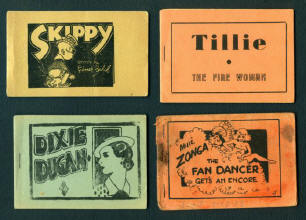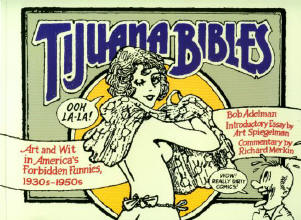|
The Tijuana Bibles (Eight-Pagers)
|
||
|
|
There is very little definitive information about "the bibles," and much speculation. Considered the first "underground comic," it is estimated that there were between 700 and 1,000 of them, printed from 1920 to 1960. In some cases, there is actually a publisher listed in the books, but either the name was fabricated or the information was patently false. One circulated rumor was that the books were printed in Mexico and smuggled into the United States through Tijuana (which was also false.) The books were printed on large sheets, ten to a sheet, then cut into strips, folded, wrapped in construction paper covers, and stapled. There was generally one cartoon panel per page, and four paper sheets per book (eight pages). They were 2½ inches tall and 4 inches wide. Those who remember buying the books (and are willing to talk about it) tell us that they were generally available where men congregated: taverns, burlesque theaters, barber shops, bowling alleys, etc. While none of them showed a price, they evidently sold for 50¢ or a dollar. The subject matter was a parody of cartoon characters, actors & actresses, stereotypes (such as traveling salesmen) and even a few famous politicians. Obviously, no consent was ever given by the original authors, actors, etc. Who the cartoonists for the bibles were is much speculated, but since no one has actually confessed to the act, I won't address it. The books were pornographic by just about anyone's standards. The male characters sported rather oversized phalluses, and the female characters seemed overjoyed by that, often regaling the reader with such demure literary endearments as "Oh, sweet baby, fuck me till the cows come home!" While the bibles lasted until well after WWII, their heyday was was during the Great Depression and Prohibition. The reference book shown by Richard Merkin (Simon & Schuster, New York, 1997) attempts to point out that they were a sign of their times, preserving the language and desires of a population in distress. Then again, maybe a lot of people just like dirty books. In my opinion, if there is any redeeming quality historically, it is this: these were the first U.S. books that dared to suggest that women enjoy sex as much as men. For a young man in the 1920's and 30's who had only read the classics and "approved" literature of the day, that had to be novel concept.
|
|


